Perhaps the greatest strategist of all time was not a business executive or an entrepreneur but a general. Helmuth von Moltke, chief of the Prussian and German general staffs from 1858 to 1888, engineered the strategy behind the military victories that allowed Otto von Bismarck to assemble a loose league of German states into a powerful empire. A prolific writer and acute thinker, Moltke possessed two important character- istics that made him a superior strategist:
The ability to understand the significance of events without being influenced by current opinion, changing attitudes, or his own prejudices.
????The ability to make decisions quickly and to take the indicated action without being deterred by a the two characteristics support each other – and apply to man- agers and entrepreneurs as much as generals and national leaders. For example, General Electric’s CEO Jack Welch has said, “Strate- gy follows people; the right person leads to the right strategy.” But what makes a strategist out of a manager? How does a CEO gauge the strategic capabilities of managers rising in the organization?
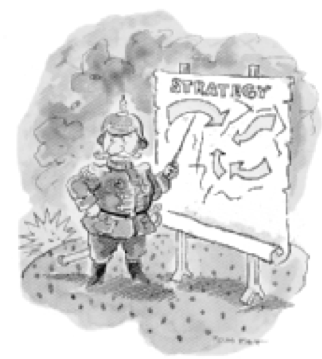
How can managers conscious- ly work on themselves to develop their own strategic abilities?
There is no test that can precisely evaluate an in- dividual’s strategic management competence. But there are key questions whose answers can indicate the level of that competence. Managers who an- swer these questions in the form of a self-adminis- tered test can draw practical conclusions about their strategic abilities. Such a questionnaire makes the process of selecting good managers more objective, clear, and simple. At the same time, this method can provide individual managers with an instrument for developing their own management personalities.
Strategy Can’t Be Taught
Helmuth von Moltke’s superior strategies won the Austrian-Prussian War in 1866 and the French- Prussian War in 1871. A man of action, Moltke was also humane and cultured – and very reserved. One colleague said he could be “silent in seven lan- guages.” Instead of giving specific orders, Moltke issued “directives” – guidelines for autonomous de- cision making. In the past, Prussian officers were discouraged from acting on their own; military commanders controlled most actions from the top. But Moltke turned such tradition on its head by ex- pecting his officers to show individual initiative.
According to Moltke, strategy is applied common sense and cannot be taught. Moltke’s general con- ception of strategy – viewing all obvious factors in the right perspective – cannot be learned in any school because every school essentially aims at mediocrity. Just as the monastery schools of the Middle Ages produced merely average monks and never saints, present-day business schools rarely turn out the equivalent of a Moltke or a Bismarck.
The actual educational purpose of any school is to achieve the highest possible average level; stu- dents learn and share values based on a common culture, which enables them to build on their own natural capabilities. The best a business school can do is to offer prospective managers ways to de- velop themselves – and refrain from creating ob- stacles or leading students down false paths. Dif- ferences in real life result much less from knowledge learned than from the individual’s es- sential character. Ultimately, the ability to strate- gize is linked with the personality of successful entrepreneurs and managers.
So, what does it actually take to be a strategist? What factors determine the level of strategic man- agement competence? Our questionnaire summarizes the criteria we use to identify good strategists. When entrepreneurs and managers take this test, they ask themselves or others ten questions. The answers then yield a profile that indicates an indi- vidual’s ability to strategize.
Question 1: “Do I Have an Entrepreneurial Vision?”
The two Steves – Jobs and Wozniak, founders of Apple Computer – envisioned the “democratization of the computer.” Gottlieb Duttweiler started Migros Cooperative, now the largest Swiss super- market chain, in 1925 with five Ford Model-T trucks loaded with sugar, coffee, rice, macaroni, shorten- ing, and soap – and a vision of scrapping traditional distribution structures to help society’s poorer classes. Enrico Mattei, founder of ENI (Ente Nazio- nale Idrocarburi), the Italian state-owned petroleum company, envisioned making Italy relatively self- sufficient in oil and natural gas. The president of a Swiss technological institute wanted to create con- ditions that would enable a member of his faculty to win the Nobel Prize. And Stephen Davison Bechtel, founder of the biggest construction company in the world, regarded the entire planet as a construction site and always stuck to his guiding principle: “We’ll build anything, anywhere, any time.”
As these and countless other examples demon- strate, there is always a vision at the beginning of any entrepreneurial activity, any major company restructuring program, any new phase in a person’s life. Such visions are guides comparable to the North Star. The leader of a caravan in the desert, where sandstorms constantly change the land- scape, looks to the patterns of the stars in the sky to stay on course. The stars are not the destination, but they do provide dependable guides for the jour- ney to the next oasis, no matter which direction the caravan comes from, how well it is equipped for the trip, or how rough the terrain may be. Of course, the stars may point the way, but any Bedouin who hopes to reach the oasis safely knows to keep one eye on the ground to avoid quicksand – and to trust his caravan leader’s sense of orientation.
Like the North Star, a manager’s vision is not a goal. Rather, it is an orientation point that guides a company’s movement in a specific direction. If the vision is realistic and appeals both to the emo- tions and the intelligence of employees, it can inte- grate and direct a company. Every entrepreneur who claims to possess strategic management com- petence should be able to state his or her vision clearly, in just a few sentences.
Of course, a vision may be more or less important to different companies and managers. A successful company intent upon steering its present course may need the ability to focus more than the ability to create a vision.
Question 2: “Do I Have a Corporate Philosophy?”
When a vision is put into concrete terms, it be- comes a corporate philosophy: the ideological creed of both entrepreneurs and their top managers. A good corporate philosophy is like a good battle cry – and, as George Bernard Shaw pointed out, a good battle cry is half the battle. Frank Stronach, the en- trepreneur who founded Magna International, an automobile parts company headquartered in Mark- ham, Ontario in Canada, bases his vision on the idea of a “fair economy.” The main principles of his corporate philosophy are:
???? 10% of profit before taxes goes to employees – 3% as cash bonuses and 7% as shares.
???? 6% of profit before taxes goes to management as cash bonuses.
???? 2% of profit before taxes goes to charities, politi- cal institutions, and educational and cultural orga- nizations.
???? 7% of profit before taxes is spent for research and development.
???? 20% of profit after taxes is paid out as dividends to shareholders.
???? The rest is reinvested.
According to Stronach’s corporate philosophy, the top management team at Magna also must be “reformed” if these managers cannot generate prof- its over any given three-year period.
A family-owned company in Austria follows a dif- ferent set of guiding principles. The company should grow, but no faster than it can finance growth with internal resources.
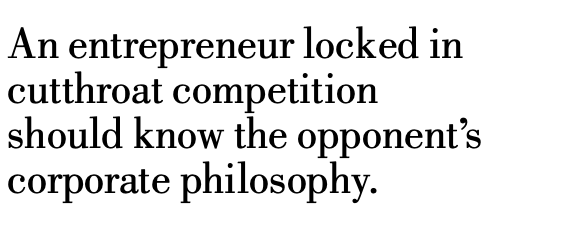
Decisions of the ad- visory board become binding only if they are unani- mous. Family members are not allowed to engage in private business activity. The company enters into no cooperation agreements with other companies. But at Olivetti, CEO Carlo De Benedetti has taken a completely different tack: his corporate philosophy emphasizes cooperation agreements, joint ventures, alliances, and the incorporation of his companies in strategic networks.
The corporate philosophy of a company is like the worldview of an individual – that combination of the most essential elements in a person’s charac- ter. Of course, it is important for a landlady sizing up a potential lodger to know something about his income; but it is also important for her to judge his character and basic ideology. Similarly, an entrepre- neur locked in cutthroat competition with a com- petitor should learn something about the competi- tor’s products and resources; however, it is even more important for the entrepreneur to know the opponent’s corporate philosophy.
Entrepreneurs and top managers who lose battles or even wars to competitors have probably failed in assessing the long-term intentions of those com- petitors. These managers may not even know enough about their own intentions. For example, the German automotive industry would do well to consider the philosophy of their Japanese competi- tors rather than assuming they don’t have to worry because Japanese cars lack European design. The Japanese today exemplify the motto, “Challengers change; our philosophy remains the same,” a view that often enables upstarts to become dominant.
Question 3: “Do I Have Competitive Advantages?”
Moltke noted that strategy is “the evolution of the original guiding idea according to continually changing circumstances.” In business, the guiding idea is to assume a unique position in the market segment in which the company operates, based on permanently maintainable competitive advan- tages. In other words, one tries to become number one or number two – or at least to be- long to the small group of leading competitors in any market segment.
But a company can capture a lead- ing market position only if it offers customers a better product or a better solution to a problem at a favorable price. The central element of any strategy consists of creating perma- nent competitive advantages that, in the ideal case, establish a virtual monopoly in the market. Examples of competitive advantages are the company’s price-performance ratio, unique product design, consistent or reliable service, and ability to deliver – in other words, the factors that motivate the buyer to choose one prod- uct over another comparable product.
The guiding idea of Franz Voelkl, a successful German ski manufacturer and former upstart, is “the one who builds his skis slowest builds the fastest skis.” When racers wearing Voelkl’s skis won gold medals during the Alpine World Championships at Lake Placid and Vail, sales boomed, con- firming his guiding idea and competitive advantage.

Skis built slowly and with care beat the “faster” competition.
Customers who want success also want to use a successful product. Unlike his competitors, Voelkl’s company produces all of the ski compo- nents in-house, including the wooden core, edges, and boot soles. This sort of manufacturing depth has produced a technically superior product – and a leap from fifteenth place to one of the top positions in the world ski market within ten years.
Artur Doppelmayr, an Austrian manufacturer of aerial transport systems, believes his main competi- tive advantage – in addition to innovative equipment design – is his service system. This allows Doppel- mayr’s company to come to the assistance of users within 24 hours anywhere in the world. Doppelmayr provides total quality management, standardization and reduction of components, a worldwide system of warehouses, and skilled personnel prepared to move immediately in emergency cases.
Both of these examples demonstrate strategies that have indirect effects. In the case of a direct strategy, such as taking the offensive in a price war, material and financial resources determine success rather than psychological factors or new-product develop- ment time. But when a company adopts an indirect strategy, such as a marketing plan that focuses on a product’s overall benefits to customers – or excluding
competitors with a clever policy of alliances – materi- al and financial resources fade into the background. Because of the acceleration of change and the increasing complexity of all human institutions, managers must learn to use indirect strategies. These are usually more effective and a better guar- antee of lasting success than a direct strategy, al- though even indirect strategies require financial
and material resources.
Question 4: “Do My Employees Use Their Ability to Act Freely in the Interest of the Company?”
In theory, the strategically managed company is a confederation of entrepreneurs, with management responsibility vested in strategic business units. These microenterprises are centers for integrated action, backed by the whole corporation’s re- sources, and headed by entrepreneurial-minded managers. Following Helmuth von Moltke’s exam- ple, corporate management should issue directives to the managers responsible for these strategic busi- ness units – but not detailed instructions. Direc- tives are guidelines for decisions reached au- tonomously and usually have a stimulating effect. Effective directives combine the strategic intention of top management with the initiative and creativi- ty of the individual manager.
For example, top management could issue the fol- lowing directive to a production manager as part of an offensive strategy: “Achieve higher flexibility through the use of increased automation, and accom- plish this within a specified time schedule and cost budget.” The manager’s task then is to be creative in figuring out the best way to meet this directive.
The success of a company essentially depends on the extent to which managers use their ability to act freely in the company’s interest. Bismarck once remarked that “courage on the battlefield is com- mon among us. But you will frequently find very re- spectable people lacking in civil courage.” He was talking about the courage to stand up for one’s con- victions; presumably, this also means the courage not to act on directives from top management – if this helps to implement strategic intentions better than passive obedience. Consequently, top manage- ment must allow directives to be modified and offer latitude for interpretation.
In everyday management practice, business-unit managers must be familiar with the overall corpo- rate vision, philosophy, and strategic intentions in order to act in accordance with them – even if the particular competitive situation forces managers to deviate from an agreement struck with corporate management. This principle, which is as much Helmuth von Moltke’s as Jack Welch’s, represents
the highest level of modern management and clear- ly promotes the greatest degree of entrepreneurial initiative. From it, we can ask a related question for evaluating the level of strategic management com- petence: Are all managers capable of expressing in just a few words the corporate vision, the corporate philosophy, and the strategic goal of the unit for which they are responsible?
If managers are not able to do this, the blame lies less with them than with their superiors, who prob- ably also lack strategic management competence. No business-unit manager can be expected to act independently and take initiative in the interest of his or her company without knowing the corporate vision, philosophy, and directives.
Question 5: “Have I Built an Organization That Im- plements My Vision?”
Entrepreneurs and top managers who feel they can improve matters by meddling at lower levels are usually mistaken. When they try, they assume func- tions normally carried out by other people, make the performance of those people superfluous, and add to their own management duties so much that they can no longer get everything done.

These obser- vations, which were made by Moltke, raise two use- ful questions in assessing strategic management competence: Are all management positions filled with people who think and act entrepreneurially? Are their duties, authority, and responsibilities such that they can formulate and implement strategies autonomously in the interest of the company?
The answer to both questions will be no if man- agers unable to meet strategic demands remain in their positions – and if the organization does not permit employees to take entrepreneurial initiative along strategic lines. Whenever that is the case, the level of strategic management competence certain- ly leaves something to be desired.
Of course, there is always a discrepancy between how the actual organization operates and how it is formally described on paper. Within limits, in fact, such a discrepancy is desirable. Capable top man- agers rely on elasticity and uncertainty in the organi- zational system in order to offer outstanding employ- ees the possibility of taking action autonomously.
Therefore, the extent to which top management has erected an organization that promotes creative be- havior and permits effective implementation of strategies reflects the general level of strategic man- agement competence.
Question 6: “Are the Line Managers Involved in Strategic Planning?”
Strategic planning is the job of those line man- agers who are responsible for implementing a strat- egy. For that reason, the key to successful execution of strategy is the early involvement of line man- agers in the strategic-planning process. This raises three questions: How do line managers temporarily become farsighted planners? How does top manage- ment use planning staff effectively? How should managers monitor the execution of strategies?
Successful companies familiarize line managers with strategic instruments in training courses and make sure they know the strategic intentions of their superiors; top management also alters plan- ning-staff functions. In this case, the function of the planning staff is no longer strategic planning. Rather, it is strategic analysis of critical sectors and
business areas that are or may be- come important for the company. Both functions support line man- agers – and both line managers and planning staff monitor progress in the execution of strategies.
If line managers are not involved in the process of strategic planning, top management certainly cannot
claim a high level of strategic management compe- tence. The same is true if strategic control is not carried out effectively or is used as a means of “po- litical” maneuvering. For example, in an Italian textile company, line managers are supposed to be free to plan and execute strategies; however, top managers use a strategic controller to quash the views of those who disagree with their personal expectations or priorities.
Question 7: “Is the Corporate Culture in Harmony with the Strategies?”
The more business strategies and corporate cul- ture are in true harmony, the higher the level of strategic management competence. Companies can only create an atmosphere of maximum creativity, for example, if they reduce hierarchical elements to a minimum. Outstanding companies are usually products of excellent entrepreneurs and managers who have created a corporate culture in which their vision, company philosophy, and strategies can be implemented by employees who think independently and take initiative.

When evaluating the general level of strategic management competence in a company, managers should ask, “Does our cor- porate culture and corporate identity – our public image and the company’s most tangible component – match the strategies?”
A company can be a management school or a school of life; theoretically, it can be both, but in re- ality this rarely happens. It is a management school if top managers set out to ground the corporate phi- losophy and strategies at all levels of responsibility in scientific principles. Among other large and mid- size corporations, Siemens, IBM, Unilever, Saint- Gobain, and Montedison have exemplified this “management school” approach.
The company is a school of life if the vision and charisma of managers – and the company’s size and that of its units – permit management on a face-to- face basis. Thus the company becomes a micro- cosm of the world rather than just a goal-oriented, single-purpose organization. This little world is not only well-organized but is also an institution that teaches living per se – the cultivation of tolerance, confidence, culture, aesthetics, taste, and humor within the framework of a common corporate phi- losophy and strategy.
Such institutions make the individual’s work meaningful and fulfill expectations that are hard to measure. Employees of “school of life” companies tend to project an active and involved work style. Of course, these kinds of companies are few and far between. And, unfortunately, their number will probably decrease.
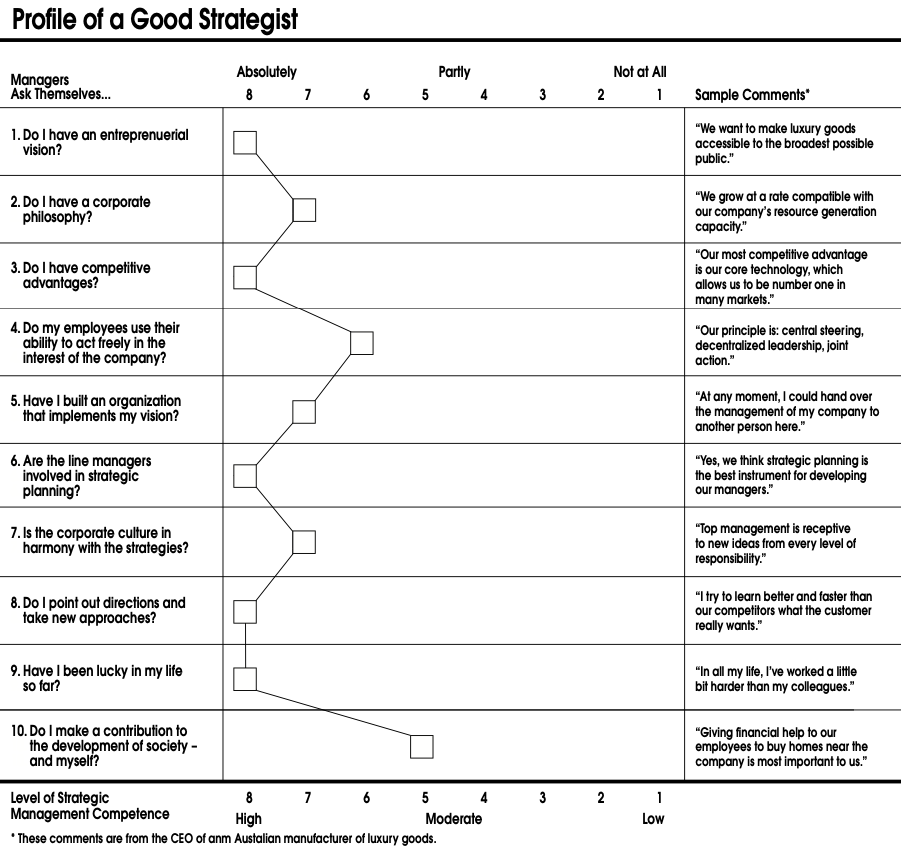
Given the economic demands of doing business in postindustrial society, an individ- ual’s personal development is often divorced from his or her development on the job.
Question 8: “Do I Point Out Directions and Take New Approaches?”
The value of great entrepreneurs or managers seems to come more from the fact that they lived than from what they accomplished. This is a coun- terintuitive conclusion; yet, sooner or later, all great business accomplishments are surpassed. What, therefore, is permanent about competent strategic management? Some possibilities include:
???? The directions great entrepreneurs and managers take, not the limits they set.
???? The projects, programs, and directions they initi- ate, not what they finish.
???? The questions they raise, not the answers they find or already know.
???? The paths they take, not the objectives they actu- ally attain.
???? The employees they select to carry on their vision, not the buildings they erect.
What is permanent about entrepreneurial capa- bilities and performance lies more in spontaneity than in education, more in originality and intuition than in learning, more in personal greatness than in specific, narrow capabilities.
A fable from India illustrates the difference be- tween knowing and being. A man went to a moun- tain and said, “What a fool you are, O mountain!
You don’t know how big you are, how high you are, or how you are shaped. But I, a mere man, know ev- erything about you!” The mountain thought and then replied, “You are right that I don’t know these things. But I am the mountain!” Knowledge of facts is not important. What matters most is a person’s understanding of who he or she really is.
In evaluating whether managers are good strate- gists, we ask: Are these entrepreneurs or managers capable of pointing directions, raising initiating actions, choosing paths, and attracting employees in a way that has lasting effects?
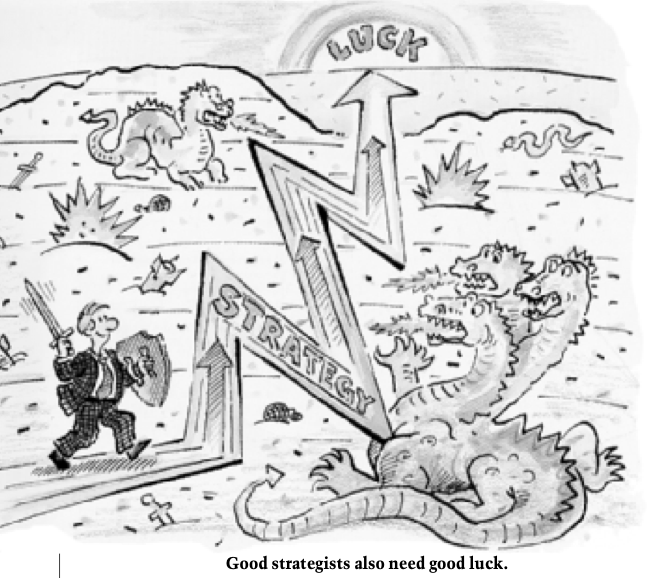
Are they capable of bringing about long-term improve- ment of the company’s growth and profitability? Whatever an entrepreneur launches with a vision can have effects that last for decades – but what he or she has to offer in terms of solutions to individu- al problems often passes into oblivion quickly. Good strategists also have the ability to make em- ployees and the outside world understand and embrace their visions.
Helmuth von Moltke is the best example of a man who knew the secret of always being armed with a “system of assistants” and transmitted the authority of his personality to his underlings. Her- mann Keyserling – a German philosopher and founder of the “School of Wisdom” popular in Eu- rope in the 1920s – noted that having integrity
means being totally honest with oneself and others, never pretending to be what one is not, and acting in accordance with one’s essential personality. Ulti- mately, a manager who is a good strategist must have such integrity.
Question 9: “Have I Been Lucky in My Life So Far?”
As Moltke observed, the good strategist also needs good luck. Put another way, strategic man- agement competence includes the ability to place
oneself in a position that favors being lucky. Many successful entrepreneurs and managers actually accomplished very little on their own. Their success required numerous other events to converge with their professional choices, which produced the “luck” they needed.
To tackle a tough challenge with good prospects for success, managers either need to feel deep down that they are up to the task – or else to trust luck to help them get the job done. However, luck in this connec- tion does not mean mere chance; rather, it means that the serendipi- tous difficulties inherent in such chal- lenges tend to stimulate and strength- en precisely those character traits necessary to succeed.
So, if we assume that human beings force their destiny by virtue of their essential character, it follows that the luckier a person has been, the higher his or her level of strategic manage- ment competence. Conversely, it is possible to rate the level of strategic management competence by the number of external setbacks and blows of fate a manager has been able to absorb without being deterred.
Question 10: “Do I Make a Contribution to the De- velopment of Society – and Myself?”
Entrepreneurs and managers who possess a high level of strategic management competence may make individual mistakes, but they do not allow themselves to be deterred from the vision, corporate philosophy, or continued development of their guiding idea. They comprehend the big picture intuitively, remaining above mundane matters and deliberately avoiding identification with them. They experience relationships both inside and outside the company, as well as strate- gy formulation and implementation, within an overall context. They also are affected more consciously and directly by the big picture than by isolated events.
This highest level of strategic management com- petence is achieved only through a lifetime of work and training. It is absolutely unthinkable for entre- preneurs or managers worthy of the name to feel they have ever reached the final goal, have a perfect solution to a problem, or have spoken the last word on any subject.
This “something” at which managers should aim over and above professional fulfillment of their managerial duties is described beautifully by Robert Louis Stevenson:
“You’ve had success in life if you
have lived decently, laughed fre-
quently, and loved a lot; won the re-
spect of clever men and the love of
children; filled out your place and ac-
complished your tasks; if you have
left the world a better place than you
found it, perhaps in the form of an
improved strain of poppy, a perfect
poem, or a saved soul; if you always appreciated the beauty of nature and also said so; if you saw the best in other people and always did your best.”
Managers and entrepreneurs should ask them- selves a final, key question: “What have we done to leave the world a better place than we found it?”
The Strategist as Student, Teacher, and Symbol
How can we tell the difference between a vision- ary strategist and an unrealistic dreamer? The an- swer must be based on a reconstruction of the per- son’s life: what he or she has accomplished or set in motion to date. In the end, strategists can be identified by measuring:
????The nature of the vision they had at the begin- ning of each phase of their career or life.
????The way in which they kept modifying their guiding ideas to suit changing conditions.
????The extent to which – and under what condi- tions – they put those ideas into action or led oth- ers to do so.
Our evaluation procedure can help top manage- ment distinguish between average managers and good strategists. (See the sample profiles on the pre- vious pages.) Using our questionnaire, company management can evaluate managers being consid- ered for an open position or a promotion by drawing up their profiles. This procedure is not intended to replace other analyses of the performance potential and intellectual horizon of an individual, but it can supplement them. Clearly, our questionnaire and the evaluation profiles are merely tools for evaluat- ing and comparing many different criteria. As with any questionnaire, the qualitative individual find- ings are more important than point scores.
Managers being evaluated complete the ques- tionnaires first. Then top management may want to discuss these questionnaires with them. The process, however, is not only self-evaluative. When top managers look at the questionnaires, they can learn something about the initiative and self-confi- dence of those who took the test.
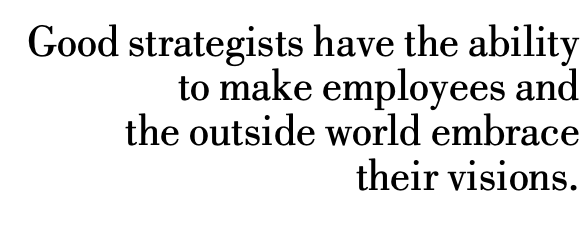
This can help them in improving the company’s managerial effec- tiveness. In fact, if the self-evaluation of managers is carried out realistically, the company average in- dicates overall strategic management competence.
As a final step in the process, top managers can also complete questionnaires in order to determine their own strategic abilities. The test may provide insight into their personal strengths and weak- nesses. Obviously, all answers should be supported by facts and examples. In general, the questionnaire can be used as part of a company’s formal evalua- tion and planning process.
Napoleon often said that he had to be present per- sonally if his armies were to win; but the battle- fields on which his soldiers fought became so large he couldn’t be everywhere at once. Consequently, the strategist in either military or business situa- tions must be not only a student but also a teacher. He or she needs employees who are thoroughly schooled in the organization’s values and strategies; only then will directives be understood and carried out even in difficult situations where the strategist cannot take personal action.
In this sense, top strategists are symbols rather than examples, because employees have the right to run their own lives. But when employees have been trained in strategic thought and action on the job – and management agrees about certain basic values such as the importance of individual initia- tive and creativity – a company legitimately be- comes a confederation of entrepreneurs.



